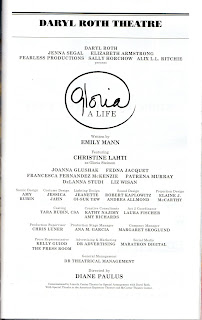“Women for Peace and Equality”
Whatever it is with late 60s political activism, it seems
like the local theatre scene can’t get enough of it. On Monday, I saw Kennedy: Bobby’s Last Crusade, a one-man
biodrama (opening November 8) about Robert F. Kennedy, who was assassinated in
1968; next, I viewed Emily Mann’s Gloria:
A Life, another biodrama, this one chronicling the career of feminist icon Gloria Steinem, who came to national prominence
in 1969; and later this week I’m booked for Days
of Rage, about three young radicals in 1969 planning to take revolutionary
action.
I can’t yet speak of Days of Rage
but both Kennedy and Gloria accomplish more as educational reminders
of their titular characters’ ideas and achievements than they do as compelling
dramas.
Seeing Kennedy on Election Eve was a bit distressing, with its depiction of a potential POTUS whose charm, eloquence, and liberal positions stand in such stark contrast to our current president. But even more immediately electric in our #MeToo moment was seeing Gloria’s story of the rise of modern feminism unfold on Election Night itself in the spacious Daryl Roth Theatre, impressively arranged by designer Amy Rubin in arena style, with an audience of perhaps 90 percent women. I’m sure many watched with their focus split between the show and the voting. One can only imagine their elation afterward to learn of the record-breaking number of women, many of them people of color, elected to important positions.
 |
| Christine Lahti, Joanna Glushak. Photo: Joan Marcus. |
Stage and screen star Christine Lahti,
herself a notable feminist, is perfect casting for Steinem. The 68-year-old is
every inch (actually a bit more than the original) the tall, still sleekly slim
84-year-old journalist, lecturer, activist, and organizer. You may remember
that, early in her career, Steinem gained great notoriety for going undercover as
a Playboy bunny to expose the working conditions of that profession. Regarding
her famously attractive looks, click
here for what she said at 83.
 |
| Company of Gloria: A Life. Photo: Joan Marcus. |
Jessica Jahn has accentuated Lahti’s low bodyfat ratio by
dressing her in heels, formfitting black tunic and slacks, a Native
American-style belt of large, linked, silver buckles, and a wig matching
Steinem’s hairdresser-heightened color. Of course, those memorable Steinem
aviator sunglasses get their moment in the sun.
 |
| Christine Lahti, DeLanna Studi, Liz Wisan, Fedna Jacquet, Francesca Fernandez McKenzie. Photo: Joan Marcus. |
Mann’s script has been composed as what is, at its heart, a one-woman
show, supplemented by a six-woman ensemble. Under Diane Paulus’s brightly tempoed
direction, it rambles through the years, on a stage laid with Oriental rugs and
a few props, flashing back to Steinem’s girlhood and family life, her college
days (at Smith), and her rise to fame in the late 60s. Among the central
situations is Steinem’s creation of MS.
Magazine, which had such a surprisingly successful impact, despite the scoffers,
that it made Ms. (which already existed) almost universal as the title for both
married and unmarried women.
 |
| Joanna Glushak, Christine Lahti, Fedna Jacquet, Francesca Fernandez McKenzie. Photo: Joan Marcus. |
As the years go by, the principal feminist issues of the day
(abortion a major one), as well as personal ones, are reflected both in the action
and in excellent stills and video sequences created by Elaine J. McCarthy and projected
simultaneously on opposite walls of the arena’s cushioned bleachers. A large
number of other women who contributed importantly to modern feminism are thus honored.
 |
| Patrena Murray, Christine Lahti. Photo: Joan Marcus. |
The versatile, physically and racially diverse ensemble—Joanna
Glushak, Fedna Jacquet, Francesca Fernandez McKenzie, Patrena Murray, DeLanna
Studi, and Liz Wisan—plays multiple roles, changing costumes partly or
entirely, to represent (often too broadly) many people, including men, in
Steinem’s life. Most colorful, on stage as in life, is Bella Abzug, played with
Abzugian flamboyance by Joanna Glushak.
 |
| Joanna Glushak, Christine Lahti. Photo: Joan Marcus. |
For all its historical interest, and its red-hot relevance
to those invested in the ongoing women’s movement, Gloria: A Life is more a docudrama than a drama, a history lesson
about a fascinating, important, still living woman. Steinem has certainly faced
hardships in her life, as with her psychologically troubled mother or the loss after
only three years of the man (David
Bale) she married at age 66 only to lose him to brain lymphoma three years
later. There are moments of sadness, moments of triumph, and moments of
laughter, but little dramatic tension.
 |
| Christine Lahti, Fedna Jacquet. Photo: Joan Marcus. |
When the final line is spoken, a brief amount of time passes
before a second act begins. This, though, is in the form of a talkback, with
the cast spread about the space, Lahti at center, and mics made available for audience
members to provide their personal responses to the feminist issues on display. Several
speakers when I attended offered interesting, even touching comments, the best
coming from a remarkably articulate girl who couldn’t have been more than 11 or
12.
 |
| Joanna Glushak, Fedna Jacquet, Francesca Fernandez McKenzie, Christine Lahti, Patrena Murray, DeLanna Studi, Liz Wisan. Photo: Joan Marcus,. |
 |
| Christine Lahti. Photo: Joan Marcus. |
OTHER VIEWPOINTS:
Daryl Roth Theatre
103 E. 15th Street, NYC
Through January 27



